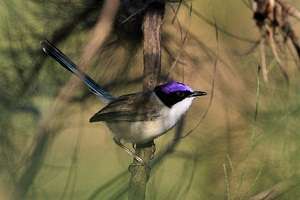Review lobbies for closer look at management techniques

A review paper advocates studying the presence of wrens (Maluridae) in local landscapes to assess the ecological soundness of land management practices.
Wildlife ecologist Dr Anya Skroblin says wrens are relatively easy to observe and are present throughout much of Australia with their behaviour, habitat, physiology and conservation status having been widely studied.
"There's really great background knowledge which then we can use when we are thinking about conservation issues," she says.
She says sympatric species also present good opportunities for understanding conservation problems.
"There's a lot of places where we have threatened species co-occurring with Malurids that aren't threatened [but] they are both experiencing the same land-management regimes," Dr Skroblin says.
"If one species is declining where the other species is not we can use that information to investigate … what fundamental factor is at play.
"So it's a way of teasing apart how these threatening processes within the landscape are influencing species."
She gave the example of the purple-crowned fairy-wren (Malurus coronatus coronatus) at Mornington Wilderness Camp in the Kimberley, where she conducted much of the field work for her PhD.
"That species is the only threatened fairy wren on mainland Australia," Dr Skroblin says.
"It's been declining in the Kimberley region and it co-occurs with the red-backed fairy-wren (M. melanocephalus cruentatus) and the variegated fairy-wren (M. lamberti rogersi) and they haven't been shown to be declining at the same rate.
"I did my PhD on the purple crowned fairy wren so I'm quite intimate with the reasons for its decline.
"It's probably due to the fact that the purple crowned fairy wren occurs on the riverine vegetation … in that area.
She says the vegetation in question is particularly susceptible to being degraded by grazing cattle and is also very fire sensitive.
Dr Skroblin says improved land management practices at Mornington Station have been beneficial to purple-crowned fairy wrens.
About half of the purple-crowned fairy-wren's habitat at Mornington Station has been de-stocked of cattle, and improved fire regimes have prevented riparian vegetation from burning.
"We've seen that the riparian vegetation has increased in density and … populations of purple-crowned fairy-wrens along the rivers have increased," she says.
"There are really interesting comparisons between what happens when we remove cattle and what happens when we allow them to remain.
"Once you understand how different species are affected by the same management regime, land managers can go about changing the way they manage their landscape."
Provided by Science Network WA




















